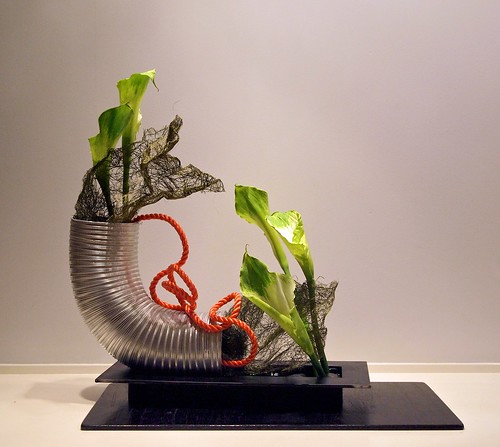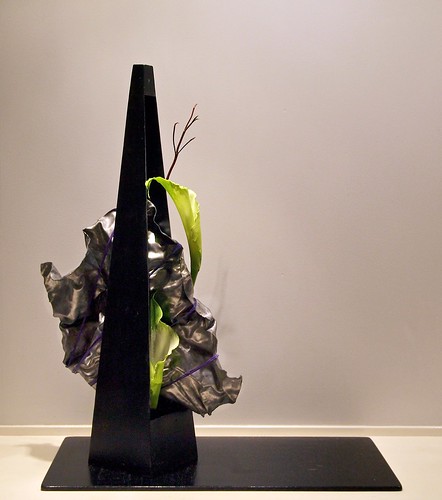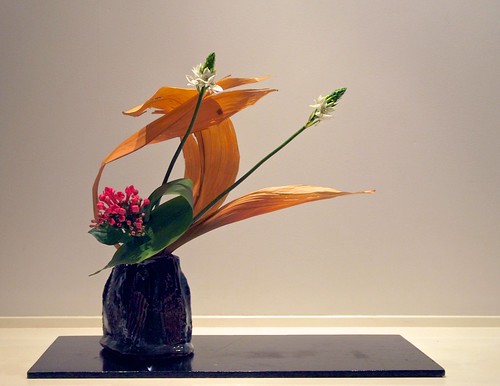Have you also heard the statement "Ikebana is art!", and wondered what it really means?
From the advent of contemporary ikebana, and especially after World war 2, the discussion on ikebana has been influenced by a western understanding of art. From being a contemplative and highly regulated art form, ruled by tradition, it is now often understood as a means of self expression and individual creativity.
 Recently this discussion has taken a new turn in western art, as ikebana works have been incorporated in concept art installations. Camille Henrot, a French artist based in New York, is maybe the most profiled exponent for this phenomenon. In the two year span of 2011-2013 she worked on the project "Is it possible to be a revolutionary and like flowers?", that was first exhibited in Paris. Last summer her work were on display at the New Museum in New York.
Recently this discussion has taken a new turn in western art, as ikebana works have been incorporated in concept art installations. Camille Henrot, a French artist based in New York, is maybe the most profiled exponent for this phenomenon. In the two year span of 2011-2013 she worked on the project "Is it possible to be a revolutionary and like flowers?", that was first exhibited in Paris. Last summer her work were on display at the New Museum in New York.Following the idea that ikebana and books are related as bearers of language but also in their function to “console the soul”, Henrot created more than 100 arrangements in tribute to the books that make up her personal library. Some of the ikebana creations were then exhibited and photographed. In this process the books are subjected to "becoming flowers".
Henrot is a trained ikebana practitioner and have studied with the Sogetsu school of ikebana. Each of her ikebana is created to represent a literary work, following a principle of reinventing the coded language that decides the shape of the arrangement and the use of flowers in traditional ikebana. Reassigning traditional ikebana codes Henrot uses the Latin and common names of the flowers, the names designed for their commercial exploitation, their pharmacological power and sometimes even the history of their travels. For example, in the ikebana piece that pays homage to the book Caractère fétiche de la merchandise (The fetishistic nature of consumer goods) she uses a rose named “freedom” and three carnations.
The coded language in Henrot's work reminds me of the allegoric messages in old European paintings, where objects and flowers are added to the composition to tell a coded story. Even though flowers are used as message bearers in ikebana, this language in my experience is often more concerned with what is understood as the inner character of the plants, than of a direct representation of an idea that can be associated with a specific flower.
 Seen separately, the ikebana works have clear references to contemporary ikebana and to iconic works by Sofu Teshigahara, founder of the Sogetsu school. Put together as an exhibition or a "library", the works must also be seen in relation to installation art and assemblages of natural materials and found objects.
Seen separately, the ikebana works have clear references to contemporary ikebana and to iconic works by Sofu Teshigahara, founder of the Sogetsu school. Put together as an exhibition or a "library", the works must also be seen in relation to installation art and assemblages of natural materials and found objects.So what happens to ikebana when it is no longer an artform in it self, but is incorporated in an installation? There are similarities between ikebana and installation art. For example, ikebana is always site-specific, or at least site-sensitive. But there are also differences. Concept art is preoccupied with an idea, a concept, whereas ikebana is much more starting with the materials themselves, working towards a conceptual expression.
Henrot's installations have been categorized as "ikebana inspired sculptures". Discussing them herself, she calls them "heterodox ikebana", deliberately based on certain naiveties and even misinterpretations of the fundamentals of ikebana: "I like to remove segments of culture in partial and unfinished manners in order to grow them in the fertilizer of my work".
 The ikebana works by Camille Henrot are being recognized as art. But are they also still ikebana? If so, with their reassigned language code and close dependence on the concept of litteratur and libraries, they certainly offer a different answer to the question what ikebana can be today.
The ikebana works by Camille Henrot are being recognized as art. But are they also still ikebana? If so, with their reassigned language code and close dependence on the concept of litteratur and libraries, they certainly offer a different answer to the question what ikebana can be today.PS: If you wonder about the title "Is it possible to be revolutionary and like flowers?", it is borrowed from Leninism under Lenin, written by Marcel Liebman in 1973, and refers to flowers as being seductive: “You start by loving flowers and soon you want to live like a landowner, who, stretched out lazily in a hammock, in the midst of his magnificent garden, reads French novels and is waited on by obsequious footmen.”
Photo courtesy: © Camille Henrot / Photo. Fabrice Seixas Courtesy the artist and kamel mennour, Paris
























